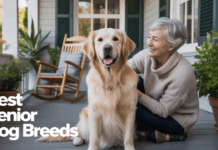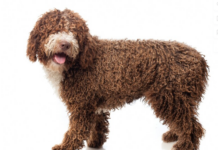Last Updated on September 26, 2024 by Dogs Vets
The Bloodhound, often hailed as the “Sleuth Hound,” is a breed renowned for its unmatched scent-tracking abilities. With their unique physical characteristics, friendly demeanor, and inquisitive nature, Bloodhounds have captivated the hearts of dog lovers worldwide. This comprehensive guide explores the breed’s traits, care requirements, training, and historical significance, ensuring that prospective and current owners are well-informed.
Overview Table
| Aspect | Details |
|---|---|
| Height | 25-27 inches (male), 23-25 inches (female) |
| Weight | 90-110 pounds (male), 80-100 pounds (female) |
| Life Expectancy | 10-12 years |
| Temperament | Independent, Friendly, Inquisitive |
| Good with Children | Not recommended |
| Good with Other Dogs | Not recommended |
| Grooming Needs | Low; regular brushing required |
1. Breed Overview: The Bloodhound’s Background
The Bloodhound has a rich history that dates back to ancient times, with some sources tracing its origins to the Mediterranean region. Recognized by the American Kennel Club (AKC) in 1885, this breed has long been celebrated for its exceptional scent-tracking capabilities.

2. Bloodhound Physical Characteristics
2.1 Size and Weight
Bloodhounds are large dogs, with males standing between 25 to 27 inches tall and weighing between 90 to 110 pounds. Females are slightly smaller, measuring 23 to 25 inches and weighing 80 to 100 pounds.
2.2 Distinctive Features
Bloodhounds are easily identifiable by their long, wrinkled faces, drooping ears, and deep-set eyes, which contribute to their solemn yet dignified appearance. Their coats can be black and tan, liver and tan, or red.
3. Bloodhound Temperament and Personality Traits
3.1 Affectionate Nature
Bloodhounds are known for their affectionate demeanor toward their families. They enjoy companionship but can be independent and stubborn, especially when on a scent trail.
3.2 Socialization Needs
While Bloodhounds can be friendly, they are not recommended for families with young children or other pets due to their high energy and independent nature.
4. Caring for Your Bloodhound: Essential Tips
4.1 Health and Wellness
Bloodhounds can be prone to certain health issues, including bloat. Owners should familiarize themselves with the symptoms of this condition. Regular vet check-ups and monitoring of diet and weight are essential.
4.2 Grooming Requirements
With a short, dense coat, Bloodhounds require minimal grooming. Weekly brushing is sufficient to remove dead hair and promote healthy skin. Regular baths will help minimize any doggy odor.
4.3 Exercise Needs
Despite common misconceptions, Bloodhounds are active dogs that require daily exercise. Regular walks on a leash, coupled with playtime in a secure, fenced area, are crucial for their physical and mental well-being.
5. Training Your Bloodhound: Best Practices
5.1 Early Socialization
Starting obedience training early is critical for Bloodhounds. Their independent nature means that consistent, positive reinforcement training is necessary to instill desirable behaviors.
5.2 Patience in Training
Due to their stubbornness, training a Bloodhound can be challenging. Owners should remain patient and utilize positive rewards to encourage desired actions.
6. Nutrition and Feeding
6.1 Choosing the Right Diet
A high-quality dog food, whether commercially manufactured or home-prepared, is essential for a Bloodhound’s health. Owners should consult with their veterinarian to ensure the diet is appropriate for the dog’s age and health needs.
7. The Bloodhound’s Role in Society
7.1 Tracking and Search Operations
Bloodhounds are often utilized by law enforcement and search-and-rescue teams due to their incredible scenting ability. They can track scents over vast distances and through challenging terrains, making them invaluable assets.
Conclusion
Owning a Bloodhound can be a rewarding experience, provided that prospective owners are well-prepared for the unique challenges this breed presents. With proper care, training, and affection, these remarkable dogs can be loyal companions and skilled scent trackers.
References
- American Kennel Club – Bloodhound Breed Information AKC Bloodhound
- Veterinary Partners – Caring for Your Bloodhound Veterinary Partners
- Dog Health Guide – Understanding Dog Nutrition Dog Health Guide
- PetMD – Training Your Bloodhound PetMD

















